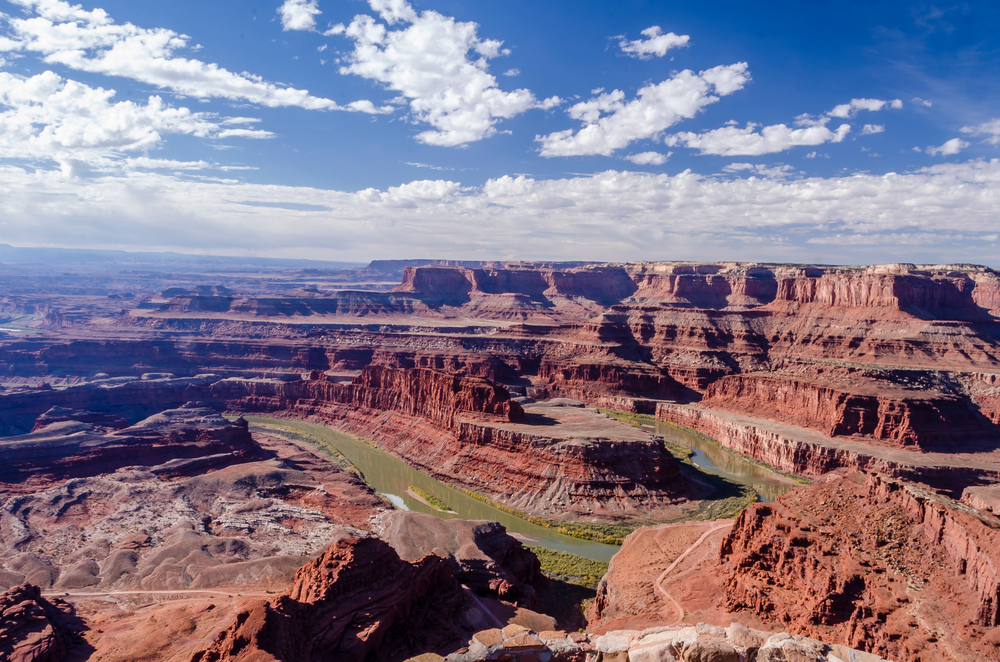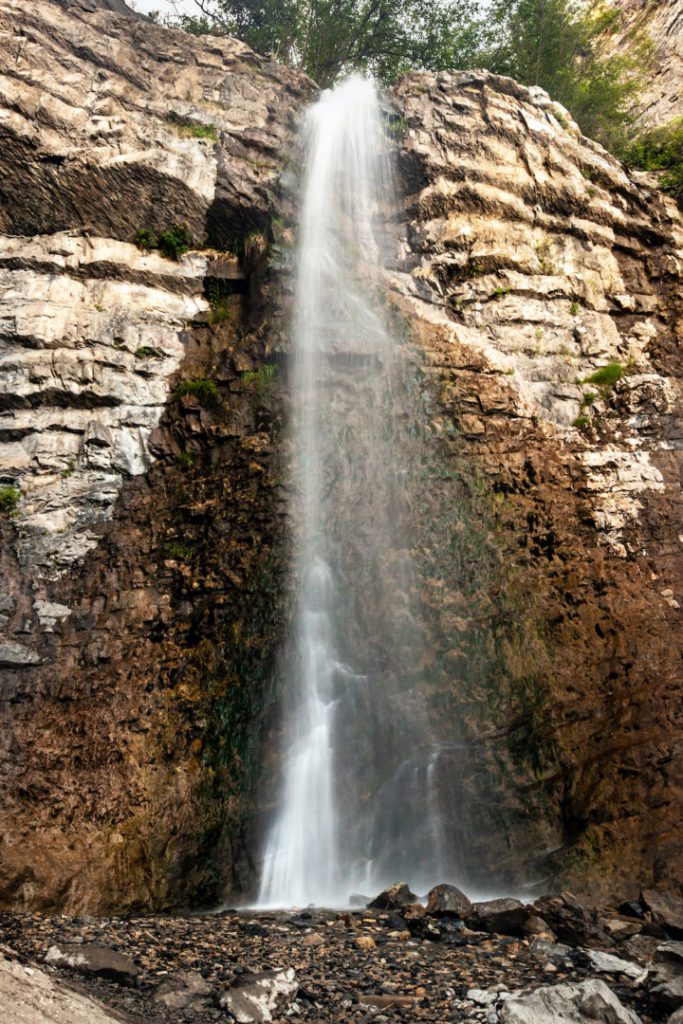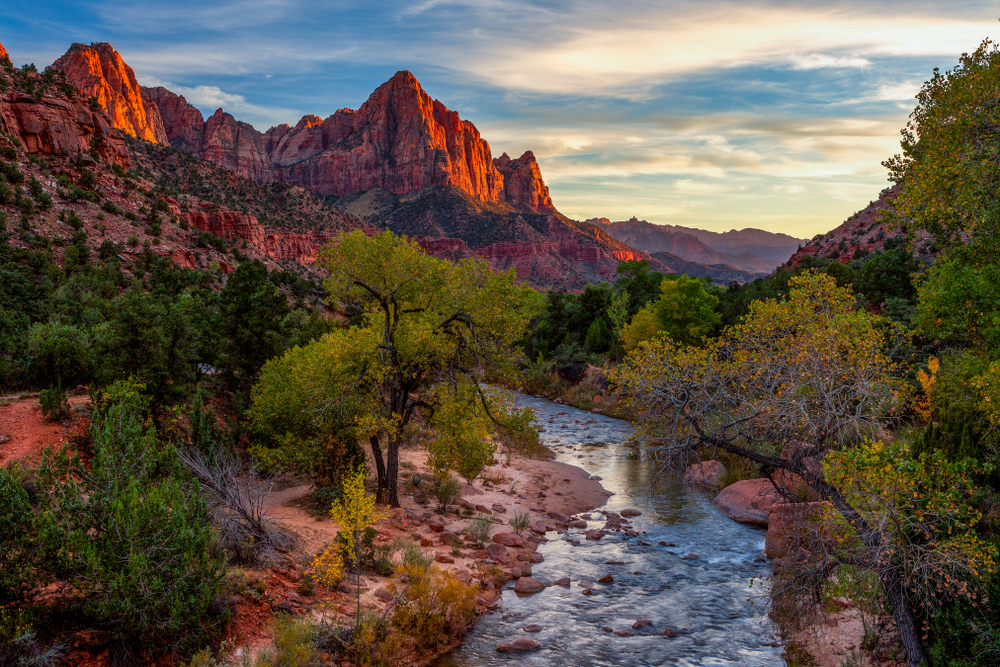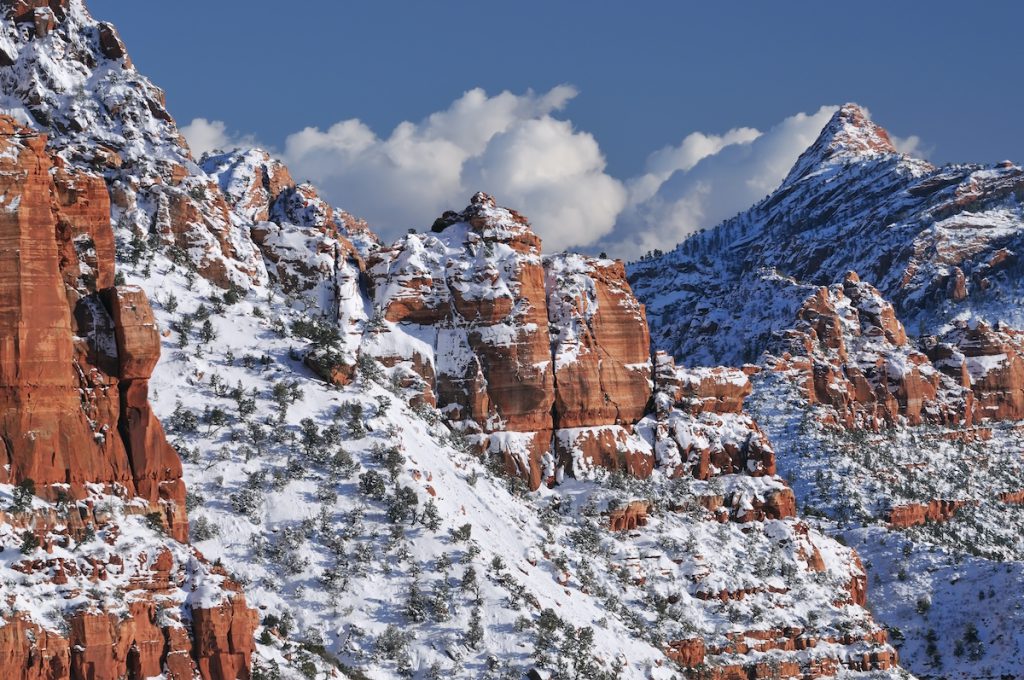
Utah is a wonderful state to visit on an RV camping trip! The state’s five national parks, open rock canyons, and rushing rivers are great spots for outdoor adventures of all types. Cities like Salt Lake City and St. George are interesting spots to explore. And historic sites like Dinosaur National Monument help us understand what the world was like long before we humans got here.
If you want to take an RV camping trip to Utah, this guide will help you out! We’ll look at everything you need to prepare ahead of time, where you should go, what you should do, and where you should stay on your trip. Here’s everything you need for a great trip to Utah!
Preparing for RV Camping
The first thing you’ll want to do as you plan an RV camping trip to Utah is…to make sure you have an RV! If you don’t have you’re own RV, you can rent one from RVshare. Then, you’ll want to make sure your RV is stocked with everything you’ll need for your trip.
Choosing the right RV for your needs
If you’re renting an RV, you’ll want to spend some time thinking about what kind of RV you want. Think about the size of your group – solo travelers or couples can manage a Class B campervan, but larger families or groups will want a Class C camper or even a Class A motorhome. You might also consider trailers if you have a vehicle to tow them.
Next, you’ll want to think about the amenities you want in an RV. Campervans and pop-up trailers have very basic amenities – often not much beyond a bed! Fifth-wheel trailers and Class A motorhomes can have impressive amenities, and some even have washing machines and fireplaces inside. And, of course, you’ll find everything in between as well!
Also, consider how you will get around once you’ve set up camp. If you have a smaller vehicle like a campervan, you can use it during the day and drive it back to camp each night. Obviously, with trailers, you’ll have your tow vehicle once you’ve set up. If you rent a Class A motorhome, you may want to tow an extra vehicle behind you. However, you may also have access to public transportation, or national park shuttles, and you may not need a vehicle at all once you’re settled at the campground!
Packing essentials for a successful trip
Packing for an RV camping trip is a balance of making sure you have all the necessities and not overpacking and weighing down your RV unnecessarily! It might help to make two packing lists – one for your personal gear and one for your RV.
Personal Packing List:
- Clothing – be sure to pack enough for your trip, or enough for between laundry days
- Toiletries
- Medications
- Bug spray or citronella candles
- Sunscreen
- First Aid kit
- Outdoor recreation clothing (hiking boots, bathing suit, or other specialized clothing)
- Winter or summer accessories (winter hats, gloves, sun hat, etc)
- Flashlight
- Entertainment (books, games, movies)
- Extra batteries
- Groceries
- Electronics & chargers
- Pet supplies
- Quarters for showers or laundry
When you make your RV packing list, you’ll want to check the listing to see what’s included with your rental. Some rentals supply dishes, linens, and even outdoor equipment or chairs while others do not. Once you know what your rental comes with, you can plan the rest of your list.
RV Packing List:
- Pots & pans
- Dishes
- Utensils – don’t forget a can opener, bottle opener, spatula, set of knives, etc.
- Dish towels & sponges
- Sheets & pillows
- Bath Towels
- Tool kit
- Folding camp chairs
- Blankets
- RV leveling blocks
- Sewer hose and adapter
- Freshwater hose
- Surge protector
You’ll also want to tailor your packing lists to where you’re going and the time of year you’re camping. Be sure to check our RV Checklist to make sure you don’t forget anything!

Considerations for Camping in Utah
Utah is known for its plethora of outdoor activities! It’s a popular state for mountain biking, rock climbing, hiking, horseback riding, whitewater rafting, and much more fun. It’s also the second-driest state in the country, and much of the state gets very hot in summer. If you’re planning outdoor activities in summer, be sure to drink plenty of water and wear sunscreen. On hot days, hike or plan your outdoor time early in the morning or in the late afternoon. Be sure to take a break and cool off if you feel overheated or fatigued.
While you’re RVing in Utah, you’ll also want to know the laws for RVs and trailers there. Every state has its own laws regarding RVs and trailers (although many of them are similar), so you’ll want to make sure you’re complying with Utah’s driving laws to avoid a ticket.
The maximum length of an RV allowed in Utah is 45 feet and the maximum width is 102 inches. The maximum trailer length is 40 feet. You can triple-tow, meaning you can tow up to two vehicles behind an RV. The maximum length for towing two or three vehicles is 65 feet unless you obtain a special permit. Passengers are allowed to ride in truck campers, and there is a 12-hour maximum time limit for parking in a rest area. Trailers that are over 3,000 pounds need trailer brakes, safety chains, and a breakaway switch.
As far as general driving rules, a right turn on red is allowed unless otherwise posted.
Researching campground options and making reservations
When you begin looking for campgrounds in Utah, you’ll want to begin by thinking about the activities you want to do and where you want to visit. Utah has lots of different regions, from urban areas to desert regions to mountains and rivers.
After you’ve decided where you want to visit in the state, you can start to look for particular campgrounds where you can stay. There are a few websites that can help! Hipcamp, The Dyrt, and Roverpass are all good websites to help you find a campsite and you can make reservations online. KOAs are a great option for families. Harvest Hosts offer unique campsites on the grounds of farms, wineries, and other scenic places.
Finding Campgrounds
You’ll want to make campground reservations, especially if you’re traveling during a popular time of year like spring break or summer. Fortunately, there are lots of Utah campgrounds to choose from! You can go luxury camping in many places in Utah, or try urban camping in places like Salt Lake City. You can also go off the grid and try boondocking!
Exploring public campgrounds in Utah
Public campgrounds in Utah include campgrounds at national and state parks, in national forests, on BLM land, and in other publically funded areas. Public campgrounds tend to have fewer amenities than private campgrounds, but they also tend to be less expensive.
National Park Camping
There are five national parks in Utah. In fact, many people plan to see all five in one long road trip!
Utah’s national parks are:
- Arches National Park
- Bryce Canyon National Park
- Canyonlands National Park
- Capitol Reef National Park
- Zion National Park
All of the parks have RV camping, but you’ll definitely want to make reservations. None of the campgrounds have hookups, so you’ll need to supply your own power and rely on campground water or bring your own.

National Forest Camping
Utah has lots of national forests where you can camp as well! This is a great option if you don’t want the crowds of a national park…and if you want some guaranteed shade while you’re camping. Dixie National Forest in Southern Utah has alien-looking hoodoos, evergreen forests, and beautiful waving aspen trees. The Manti-La Sal National Forest covers 1.2 million acres and has hiking, mountain biking, and whitewater rafting in summer and skiing, snowboarding, and snowmobiling in winter.
State Park Camping
Along with Utah’s lovely national parks, the state has many awesome state parks as well! From lakes to red rock valleys to mountains, you can experience Utah’s vast and varied landscape at the many parks in the state.
Great Salt Lake State Park is a wonderful place to experience the unique lake Utah is known for. Watch sailboats from the Great Salt Lake Yacht Club as they drift by, or pop into the visitor center to learn more about this lake. Goblin Valley State Park gets its name from the many hoodoos – also known as goblins – that dot the area. Palisade State Park has a golf course and full-service restaurant, off-road vehicle trails, and great fishing.
Bureau of Land Management (BLM) Camping
Bureau of Land Management camping is another great way to use public campgrounds in Utah! The White House Campground is in a valley between sandstone buttes and the Paria River. A nearby trail leads to the Paria Canyon-Vermilion Cliffs Wilderness, and the campground is on the southern edge of the Grand Staircase-Escalante National Monument. Lower Onion Creek Campground is along the banks of the Colorado River near Arches and Canyonlands National Parks. The Sand Island Recreation Area is a great spot for BLM RV camping as well. The Sand Island Petroglyphs feature Anasazi rock art images, and Arches and Canyonlands National Parks aren’t too far of a drive.
If you plan to camp on BLM land, know that campgrounds have very few amenities – or none at all! You may need to provide all of your own power and water. Be sure to leave no trace when you finish your trip as well.
Exploring private campgrounds and RV parks
Along with public campgrounds, there are lots of private campgrounds in Utah as well! If you prefer glamping, try the Escalante Cabins and RV Park where you can hike, bike, fish, and go ATVing. The Zion Ponderosa Ranch Resort has luxury RV campsites near Zion National Park. Along with RV camping, the resort has luxury cabin suites, Conestoga wagons, canvas tents, and vacation homes.
Even if you’re not looking for the full glamping experience, you have a great chance of finding RV campgrounds in Utah with hookups and dump stations.

Boondocking in Utah
If you want the opposite of a private Utah campground and want to boondock on your trip, there are plenty of options for getting off the grid! The Uinta-Wasatch-Cache National Forest has great boondocking options, as do the dispersed camping areas near Hole-in-the-Rock Road.
Planning your itinerary
Now that you know what kind of RV you want, and where you want to camp, it’s time to narrow down your itinerary! Utah offers a variety of activities – whether you want history, nature, or the thrills of an adventure park, you’ll find something here.
Features and attractions in Utah
Driving one of Utah’s many scenic byways is a great way to see the state’s amazing geological features! Scenic Byway 12 doesn’t sound very exciting, but the 124-mile road connects Bryce Canyon National Park with Capitol Reef. You’ll see desert, sandstone rock, waterfalls, and forests along the drive and it’s also one of the best places to view the stars. The Trail of the Ancients drives you through areas inhabited by the Ancestral Puebloans, known for their cliff dwellings.
You may also want to check out some of Utah’s top landmarks. The Bonneville Salt Flats make a stark landscape, and are also known for being the area where some of the top land speed records in the world have been set. Timpanogos Cave National Monument is tricky to get to, but rangers offer fascinating cave tours and there are other hiking trails as well.
Make sure to visit some national sites as well! Glen Canyon National Recreation Area includes Lake Powell, a popular spot for boaters. The Golden Spike National Historical Park commemorates where the transcontinental railroad was joined. And the Mormon Pioneer National Historic Trail runs from Illinois to the Salt Lake Valley and traces the route of Brigham Young and his congregants.
Festivals, fairs, and events in Utah
You may want to take your RV camping trip to celebrate a special event in Utah, like the state fair or a food or arts festival. The fair has campgrounds nearby where you can stay. In fact, sometimes for an extra fee, RV rental owners will come set your RV up for you at the campground. That way you can get right to the fun when you arrive!

Exploring Outdoor Activities in Utah
Utah is well-known as an outdoor adventure destination! From rafting to hiking to mountain biking in summer and skiing and snow sports in winter, you’ll find plenty to do here.
Hiking, biking, and nature trails
Hiking is a wonderful way to explore parts of Utah, and it’s an inexpensive activity the whole family can enjoy! Be sure to bring plenty of water and plan around hot temperatures in the summer by going early in the morning or in the late afternoon.
Some of the best hiking trails in Utah include:
- The Watchman Trail
- Gloria Falls
- Wall Street and Queens Garden Loop to Peekaboo Loop
- Double O Arch Trail
- Stewart Cascade Trail
If you’re looking for a mountain biking adventure instead, try one of these trails:
- Waterfall Canyon Trail
- Pa’rus Trail
- Orson Smith Park to Draper Suspension Bridge Loop
- Avenue Twin Peaks
- Bear Canyon Bridge via Bonneville Shoreline Trail
Fishing, boating, and water activities
Getting out on the water is a great way to enjoy a vacation! And although Utah is an arid state, there are plenty of lakes and rivers where you can enjoy water activities. Try fishing on Lake Powell or along the Green River. Enjoy a day at one of Utah’s best beaches. You can also look for one of the many waterfalls across the state.
Wildlife viewing and photography
Utah is home to tons of wildlife – try to spot some and perhaps even take a picture! You can find bighorn sheep, coyotes, mountain lions, bobcats, moose, bears, and smaller animals like raccoons, bats, and weasels.
If you want to view wildlife in Utah, here are a few tips. Since the desert can be hot during the day, many animals venture out at dawn, dusk, or after dark. During the day, you may see lizards, snakes, birds, or squirrels while at night you might see kangaroo rates, skunks, ringtails, or owls. National parks and Utah’s state parks are great places to try and spot some wildlife.
Family-friendly activities and attractions
If you’re visiting Utah with your family, you’ll find plenty of things to do! Head out hiking or rafting for the day, spend a day learning about the history of the area, or head to a local amusement or water park to cool off on a hot day. Be sure to explore urban areas like Salt Lake City or St. George as well.
Historical sites and museums
Utah has lots of history to experience – from prehistoric times on! Visit Dinosaur National Monument to learn about the behemoths that roamed the earth millions of years ago. In Salt Lake City, you can visit Temple Square and learn about the history of The Church of Jesus Christ of Latter-day Saints, which is deeply intertwined with the history of the state. Rainbow Bridge National Monument is a sacred site for many Native American tribes. Boat tours allow you to experience the bridge from a unique perspective, and you can learn about how the bridge has been a significant religious site for thousands of years.
If you want to check out some of Utah’s museums, the Natural History Museum of Utah is considered one of the best in the state. The Hill Aerospace Museum in Roy, UT is a military aviation museum with aircraft from World War I through the present day.
Amusement parks, zoos, and wildlife refuges
If you want to spend a day of thrilling fun with the family, Utah is home to many amusement parks and waterparks! Lagoon Amusement Park just outside of Salt Lake City has rides for kids of all ages! There are thrilling roller coasters for older kids and adults and tamer rides for younger kids. Lagoon A Beach has a lazy river, waterslides, and other fun rides to cool off. Cache Valley Fun Park in Logan is an indoor fun center, so it’s a great spot when the weather is cold or snowy. You can bowl, roller skate, or play arcade games…or try something more adrenaline-pumping like laser tag or axe-throwing.
If you want to visit a Utah zoo, the Hogle Zoo is in Salt Lake City and has more than 800 animals on 42 acres. You can even feed a giraffe at the zoo!
If you want to see animals in the wild, consider visiting a Utah wildlife refuge. The Bear River Migratory Bird Refuge is on the northeast side of the Great Salt Lake. You can view more than 200 species of birds here. Take the 12-mile-long drive around the wetlands, where you might get a view of a white-faced ibis, a snowy egret, or a black-crowned night heron. The Ouray National Wildlife Refuge is in the desert of northeast Utah, near the Green River. The river attracts water-loving birds to the dry area and is a great spot for breeding and resting migratory birds.

Safety and Preparedness when RV Camping in Utah
Utah is a beautiful and exciting place for an RV camping trip! However, there are some dangers in the state and it’s good to know ahead of time what to do in case of an emergency. For more RV safety tips, be sure to read our guide to RVing safely!
Weather conditions and natural disaster preparedness
The most common natural disasters in Utah include earthquakes, floods, and wildfires. If you encounter an earthquake while in your RV, seek shelter under a table and away from light fixtures or windows that can break. If your RV is parked near a tree, light pole, or other hazard that could fall and crush it, consider running outside during the earthquake instead. However, the best option is to avoid that danger when you park your RV in the first place. After an earthquake, do not like any matches or candles in case of a propane leak. Use flashlights until you are sure there’s no gas leak.
To prevent wildfires, be sure to check the fire restrictions for the area where you are camping. Know how to safely start and put out a campfire if you are allowed to have one. Also, check any other restrictions such as charcoal fires, to be sure you’re cooking safely. When you’re determining where to camp, consult a fire map to make sure you’re well away from any danger.
In case of a flood, be careful while driving your RV. Flooded areas can be deceptive, and you can accidentally drive somewhere that has more water than you thought. Be sure to head to higher ground during flooding. Listen to local radio or TV weather reports so you know if the storm is continuing. You’ll also want to listen to whether your area needs to evacuate.
Wildlife encounters and precautions
Utah is home to lots of wildlife! Take precautions while hiking, mountain biking, or otherwise enjoying the outdoors to make sure you don’t startle a large animal like a bear or mountain lion! Don’t let children or dogs run ahead on trails. Read all posted signs warning about wildlife, and follow the advice on what you should do if you encounter an animal. At your campsite, make sure you safely secure all food and other scented items in a bear box or bear-proof container.
Utah’s red rocks, rushing rivers, and towering mountains make the state synonymous with outdoor fun! There are many places to visit on an RV camping trip to Utah that guarantee you’ll have memories to last a lifetime.
More Inspiration for Your Utah Travels
- Top 6 Amusement Parks in Utah
- Urban Camping in Utah
- Top 10 Waterfalls in Utah
- Luxury Camping in Utah
- Glamping in Utah
- Fishing in Utah
- Top 10 Beaches in Utah
- The Top 33 Bucket List Destinations in Utah
- Boondocking in Utah
- Top 10 Landmarks in Utah
- The 15 Best RV Trips to Take in Utah
This post may contain affiliate links.
